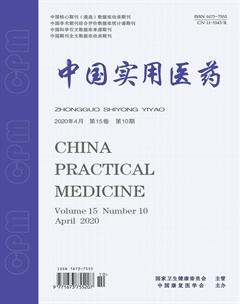經股動脈入路和經橈動脈入路行全腦血管造影術的應用效果觀察
孔杰 占大權


【摘要】 目的 觀察經股動脈入路和經橈動脈入路行全腦血管造影術的優缺點和并發癥發生情況。方法 97例行全腦血管造影術的患者, 根據手術路徑的不同分為經股動脈組(53例)和經橈動脈組(44例)。經股動脈組采用經股動脈入路行全腦血管造影術, 經橈動脈組采用經橈動脈入路行全腦血管造影術。觀察比較兩組患者穿刺成功率、手術時間、手術成功率、術后并發癥(栓塞事件、穿刺處大血腫、假性動脈瘤、尿潴留)發生情況。結果 經股動脈組穿刺成功率100.00%高于經橈動脈組的90.91%, 差異具有統計學意義(P<0.05)。兩組手術時間比較, 差異無統計學意義(P>0.05)。經橈動脈組手術成功率100.00%高于經股動脈組的90.57%, 差異有統計學意義(P<0.05)。經橈動脈組并發癥發生率4.55%低于經股動脈組的18.87%, 差異有統計學意義(P<0.05)。結論 兩種手術路徑均能很好地完成全腦血管造影術, 經股動脈入路穿刺難度較低, 易于掌握, 但并發癥較多。經橈動脈入路并發癥較少, 但穿刺成功率較低, 對術者要求較高。
【關鍵詞】 全腦血管造影術;經股動脈入路;經橈動脈入路
DOI:10.14163/j.cnki.11-5547/r.2020.10.009
【Abstract】 Objective ? To observe the advantages, disadvantages and occurrence of complications of the whole brain angiography through the femoral artery approach and the radial artery approach. Methods ? A total of 97 patients with total cerebral angiography were divided into femoral artery approach group (53 cases) and radial artery approach (44 cases) by different operative approaches. Femoral artery approach group received total cerebral angiography through femoral artery approach, and radial artery approach group received total cerebral angiography through radial artery approach. The success rate of puncture, operation time, surgical success rate, occurrence of postoperative complications (embolism event, large hematoma at the puncture site, pseudoaneurysm, urinary retention) between the two groups were observed and compared. Results ? The success rate of puncture 100.00% in femoral artery approach group was higher than 90.91% in radial artery approach group, and the difference was statistically significant (P<0.05). There was no statistically significant difference in operation time between the two groups (P>0.05). The operative success rate 100.00% in radial artery approach group was higher than 90.57% in femoral artery approach group, and the difference was statistically significant (P<0.05). The incidence of complications 4.55% in radial artery approach group was lower than 18.87% in femoral artery approach group, and the difference was statistically significant (P<0.05). Conclusion ? Both operative approaches can complete the whole cerebral angiography well. The femoral artery puncture is relatively difficult and easy to master, but there are many complications. The radial artery approach has fewer complications, but the success rate of puncture is lower, and the requirements for the operator are higher.
【Key words】 Total cerebral angiography; Femoral artery approach; Radial artery approach
[3] Campeau L. Percutaneous radial approach for coronary angiography. Cathet Cardiovasc Diagn, 1989, 16(1):3-7
[4] Novara AM, Kallmes DF. Transradial cerebral angiography: technique and outcomes. Am J Neuroradiol, 2003, 24(6):1247-1250.
[5] Moran CJ, Milburn JM, Cross DT, et al. Randomized controlled trial of sheaths in diagnostic neuroangiography. Radiology, 2001, 218(1):183-187.
[6] Kiryosue H, Okahara M, Nagatomi H, et al. 3.3F catheter/sheath system for use in diagnostic neuroangiography. Am J Neuroradiol, 2002, 23(4):711-715.
[7] 趙美英, 王潤青, 劉威, 等. 缺血性腦血管病腦血管造影及介入治療術后并發癥的分析與處理. 中國實用神經疾病雜志, 2015, 12(5):85-86.
[8] 李衛東. 缺血性腦血管病介入診斷和治療的臨床研究. 中西醫結合心血管病電子雜志, 2015, 16(3):77-78.
[9] 艾克拜爾·加馬力, 關玉華. 經橈動脈與經股動脈途徑全腦血管造影的對比分析. 臨床醫藥文獻電子雜志, 2018, 5(10):130-131.
[10] 廖耿, 薛華杰, 黃婉蕓, 等. 經橈動脈與經股動脈途徑行選擇性全腦血管造影的對比研究. 中國醫藥科學, 2012, 2(21):19-20.
[11] 蘇江利, 亓立峰, 曲懷謙. 經橈動脈途徑行全腦血管造影的可行性與安全性研究. 中華解剖與臨床雜志, 2014(4):294-298.
[12] 黃永軍, 安紅偉, 鹿俊磊, 等. 經橈動脈和經股動脈途徑行全腦血管造影臨床對比分析. 山西醫藥雜志, 2013, 42(3):298-300.
[收稿日期:2019-08-14]

